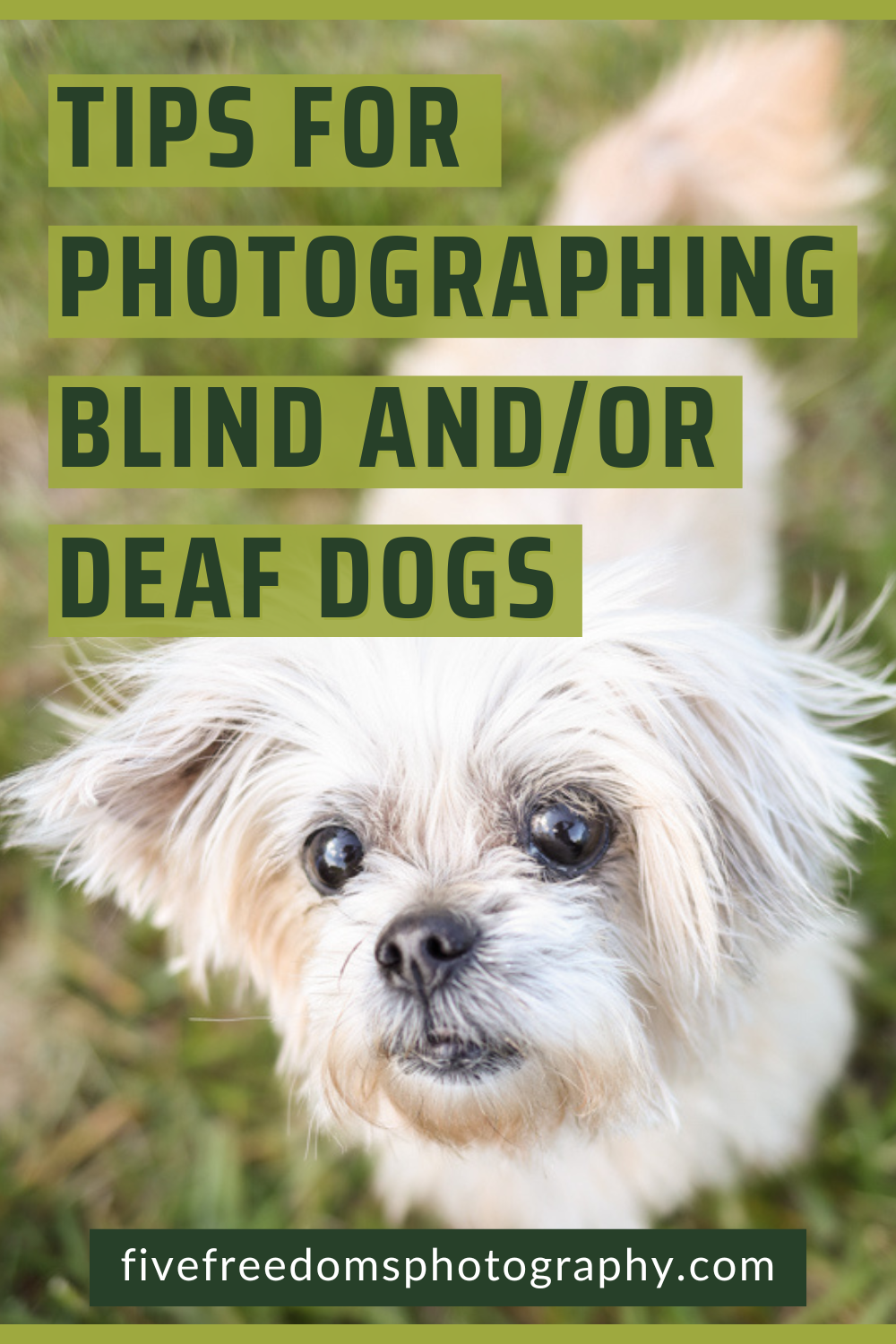Tips For Photographing Blind / Deaf Dogs As A Pet Photographer
I love working with blind and/or deaf dogs.
Not only are they a good challenge as a pet photographer, but because they don’t have some of the same overstimulation that seeing and hearing dogs do, they can be quite silly and joyful!
If you’re just getting started in rescue or working with dogs as a pet photographer, there are some key things to know about working with dogs who are both blind and deaf or limited in one or the other.
In fact, I’m sharing all those things and more in this post. (Or if you prefer, you can watch the full video with all of our tips here)
Pssst… love this post? Be sure to pin it to Pinterest!
Tips For Photographing Blind And/Or Deaf Dogs
In my experience, most blind and deaf dogs rely heavily on their nose to understand the world; however, I have worked with some blind and/or deaf dogs that have one sense that’s entirely non-existent while maintaining another sense on a limited basis.
That could look like a dog being completely deaf, but has partial eyesight in one or both eyes like a senior dog. Or they could have no eyesight, but have extremely limited hearing, which is where your squeakers and other loud noisemakers can come in.
TAKE STOCK OF WHAT SENSES THEY LACK AND WHICH ONES THEY MAINTAIN
So, that’s what I want you to pay attention to first when photographing a blind or deaf dog; the levels at which they are limited and what senses they do still maintain.
Obviously, if they are fully blind or deaf, you’ll want to take advantage of the senses they do have, which are touch, smell, and the use of their mouth or taste.
USE THE STINKIEST / SMELLIEST TREATS POSSIBLE TO GET THEIR ATTENTION
If the dog has lost all sight and hearing, I will use lure the treat in front of their nose to get them to look up at me or in my general direction.
Because they really have to use their nose to make sense of the world around them, you will regularly see a fully blind/deaf dog, pick up their nose in the air and constantly look one way or the other as their sniffer is being put to work.
Personally, I love a good profile shot when they do that, but to get them to look forward for portraits, be sure to put a treat in front of their nose and lure it away from them. You likely will have to do this over and over again to get the final result that you want and that’s totally normal.
When you are luring their nose upwards with a treat, they may also move towards you when you do this, but you can take advantage of that motion for some walking or movement shots.
INCORPORATE PLAY
Another thing I love to do with blind and deaf dogs is incorporate play by giving them toys, so they can mouth on something and that provides sensory enjoyment for them during our session together. It also allows them to participate in innate behaviors.
When that happens, I simply photograph them as they are behaving, which can make for a lot of silly and cute shots. A tennis ball is always a good option, but stuffy toys that squeak with lots of textures are even better.
UTILIZE THEIR PET PARENT/FOSTER PARENT/OR VOLUNTEER HANDLER
Lastly, for blind or deaf dogs, take advantage of your pet parent, handler, or volunteer, it’s likely the dog will stay very close to whomever they are bonded with because some of these dogs I’ve found like to be able to feel the closeness or nearness of their person to know where they are at all times.
Of course, the dog can also smell them being near, too.
So, you can utilize the handler by having them move away from the dog for some motion or action shots as the dog will follow.
Another thing you can do, if the dog is trained with touch signals, is have the handler tell them specific commands, like sit or down, with the touch of a hand or finger. That will help to give more variety throughout the session, too.
Even if the dog isn’t trained with specific touches, most pet parents have their own language with their dog on how to get them to perform specific tasks, like sit or stay.
I do recommend also incorporating the handler or pet parent for cuddling shots as these dogs are usually very closely bonded with their people and those are just always super sweet photos to capture.
OTHER THOUGHTS
If the dog has limited sight, you can still take advantage of toys to get their attention or their person making funny faces and movements to keep them intrigued during the session.
Conversely, if the dog is blind, but can still hear, like I mentioned earlier, then scent and noises are going to be your best bet.
The more you photograph blind and deaf dogs, the more you will start to understand how they interact with the world and pull out some of these things I’ve shared to help receive the best result and cutest photos from your time together!
Now, I’d love to hear: which piece of advice was your favorite from this post? Or what have been your experiences photographing blind or deaf pups? I’d love to know in the comments below!
WORK WITH US
OTHER POSTS YOU MIGHT ENJOY
Tips For Photographing Black Dogs
Tips To Get Your Dog To Pay Attention For Photos
EDUCATION FOR PET PHOTOGRAPHERS
50+ Ways To Market Your Pet Photography Business
A Beginner’s Guide To Dog Photography



